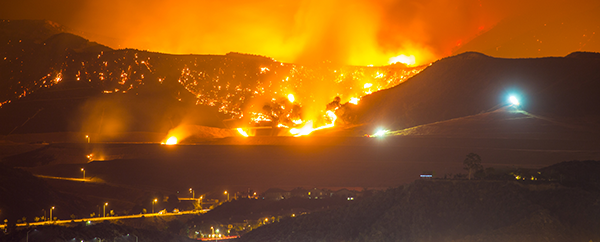ACM field investigators: immediate CA wildfire response
So far this year, 6,400 wildfires have burned 250,000 acres and destroyed 600 structures. Many of our homeowners have been affected in the California fires. Even before claims were filed, ACM was on the job, providing an immediate CA wildfire response. Fire locations were mapped; policyholders with the highest potential to be in the fires’ paths were determined.
ACM’s response team began making calls to check on people in the fires’ direct paths. Call centers were fully staffed, and field adjusters were on the scenes the next day to work one-on-one with homeowners.
Imagine being awakened in the middle of the night by police and ordered to evacuate your home. When the door opens it looks like something out of a war zone – fire burning in the hills around you, ash falling from the sky, and people rushing to load family and pets into their cars to get away.
This may sound like a movie, but it’s a real account given by an Arrowhead personal insurance customer from Canyon Country, evacuated due to the Tick wildfire. For many thousands of Californians this has been all too real, as drought conditions conspired with Santa Ana and Diablo winds to fuel wildfires all over the state.
Related: Fire Prevention Week: Check Your Smoke Alarms
“As we have done before, we distributed the policy lists to veteran adjusters and managers. We asked them to make calls and check on people that were in the direct path,” explained Tim Allen, ACM’s senior vice president of property claims. “It’s a very simple task, but the personal touch is really well-received. Being called by a representative of their insurance company just to check on them surprises many people. Even if they have no damage, a wildfire is a major event in their lives, and they welcome the opportunity to tell their story and ask questions about their coverages.”
ACM initiated their Catastrophe Response Plan: “This is where ensure resources are in place in the event of many claims coming in,” says Allen. “Our call centers are staffed up. Field adjusters are dispatched to the affected areas. Weekend and after-hours teams are assembled so we can be ready. Our CA wildfire response team was in place within a day or so.
“When necessary, we conduct refresher training and partner with clients so that updates are handled in real time,” he added. “This is the same response we initiate with any potentially large-scale event, and that included last year’s fire season.”
Related: ACM participates in recovery after 2018 California wildfire claims
According to US Forest Service and Interior Department officials, early projections indicated that the 2019 fire season would possibly be worse than the year prior, stating that “if we’re lucky, this year will simply be a challenging one.” This assessment was based on the fact that the state has in recent years seen consistently destructive fires more often than ever before.
Many of these 2019 wildfires were caused by either lightning strikes or downed/malfunctioning power lines. As of publication of this blogpost, PG&E is offering $13.5 billion in compensation to 2017 and 2018 wildfire victims as part of the bankrupt utility’s restricting plan. This year, they initiated a series of rolling blackouts that crippled local businesses and wreaked general havoc, but hopefully helped mitigate fire risks in some areas.
Related: Natural disaster aftermath: Employee safety tips
As many as 90 percent of wildland fires in the United States are caused by people, according to the U.S. Department of Interior. Some human-caused fires result from campfires left unattended, the burning of debris, downed power lines, negligently discarded cigarettes and intentional acts of arson. The remaining 10 percent are started by lightning or lava, according to an Insurance Information Institute report.
Verisk’s 2017 Wildfire Risk Analysis reports that 4.5 million U.S. homes were identified at high or extreme risk of wildfire, with more than 2 million in California alone.
According to the New York Times, in 2017 and 2018 California experienced the most destructive blazes in the state’s recorded history. Thousands of homes were lost, and there were 86 deaths.

